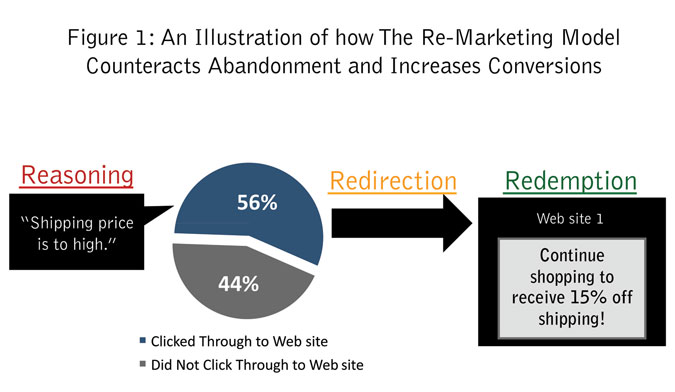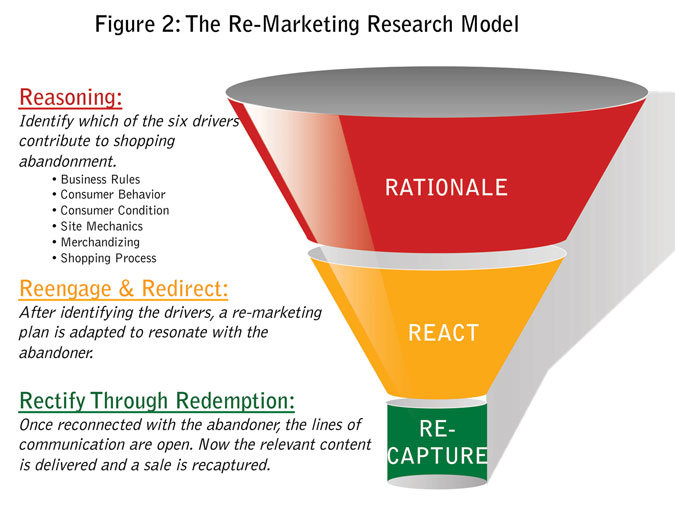Make 'em an offer they can't refuse
Editor’s note: Kimberly Struyk is director of client service at CRM Metrix, a Secaucus, N.J., research firm.
Editor’s note: Kimberly Struyk is director of client service at CRM Metrix, a Secaucus, N.J., research firm.
The objective for e-commerce Web sites is always the same: drive sales and revenue. Yet, e-store abandonment rates remain at 90 percent. Naturally, when visitors are not convinced to hit the purchase button during their session this raises site abandonment rates and lowers sales and revenue numbers. When speaking about abandonment rates - a critical metric - there are often misconceptions that require clarification. The reasons behind abandonment are not always due to site usability, as might typically be anticipated.
Extensive research reveals that abandonment is broken down into six key drivers: consumer condition, consumer behavior, merchandizing shortfalls, business rules, site mechanics and, lastly, pain points within the shopping process.
Further, there are varying degrees of persuasion needed to recapture the sale. By uncovering the true reasons behind abandonment, we can build best practices for transactional Web sites and also foster the emergence of new strategies. This information is derived from the behaviors that can be changed within each point of the conversion funnel and can be adapted as a business model across all transactional Web sites. Through observations about the change in consumer behavior during the online shopping experience, a “re-marketing research” model is born, one that focuses on the rationale behind, reaction to and recapture of abandonment.
Take several actions
Thinking about today’s online shopping environment, consumers can take several actions within the online setting. They can shop directly on brand Web sites; visit competitive Web sites or aggregator sites (i.e., Amazon.com); or seek input from consumer opinion sites through reading blogs or by obtaining recommendations from friends on Facebook. We can go on and on about strategies used for online shopping, but the important fact is that a brand must stand out when it has the customers’ attention (the span of which is getting shorter and shorter).
The research process starts with assessing why consumers are coming to the site and identifying improvements they would like to see when visiting. Uncovering visitor objections lets the site react and rectify the situation but most CRM programs do this by sending an e-mail to the consumer - resulting in a delay between the conversation linking the brand and the customer. As a result, the response may become irrelevant, especially if the shopper already purchased elsewhere. To keep up with the pace of Internet shopping behaviors while greatly increasing the likelihood to change the mind of a consumer, the “reaction phase” approach uses research to handle the reaction to consumer opposition in real-time.
During the reaction phase, the results from the rationale phase (insights related to abandonment) are examined and then reacted upon by the research system. This immediate reaction phase is what allows the brand to rectify the situation by redirecting the sale toward completion. Recalling that this model is built upon six core drivers of abandonment (with usability being the least likely to drive visitors away), in most cases there are three common strategies all sites should know about and build best practices around:
- Be sure to assist with comparison shopping.
- Show the price up front as soon as possible.
- Always manage the product discontinuation process.
Best practice #1: Assist with comparison shopping
Assisting with comparison shopping is the common dominator across all Web sites, meaning it is an applicable feature needed for both transactional and non-transactional Web sites. Moreover, the evidence shows that visitors use the Web for research first and foremost. With that said, think about the first thing visitors typically do when conducting research for products. They most likely compare and contrast everything about the product or service (price, specifications and alternatives). This suggests that visitors will often find themselves left switching back and forth from site to site.
With visitors looking to compare and contrast so often, there is a basic need still not being met during the Web site experience. The comparison is often accomplished by using a content aggregator site or another tactic (i.e., writing on paper). While keeping in mind any potential legal concerns, sites should attempt to provide a comparative view for visitors. Implementing a meaningful compare-and-contrast feature assures that brand differentiation is clearly on display for all, thereby undoing any confusion with alternatives. Without the ability to compare, visitors will be toggling back and forth between your brand and your competition.
Best practice #2: Show the price up front as soon as possible
In tandem with comparison-shopping, e-store shoppers are most appreciative of having products linked with pricing, avoiding excessive clicks. Leading by example, e-commerce giant Amazon.com always shows the price point up front for fast and easy decision-making, which should be goal of all e-stores. Those who abandon deep within the shopping cart process are often just checking the price and/or shipping cost, which indicates that these visitors are inappropriately classified as abandoners rather than researchers. Providing up-front communication about pricing is the avenue to a better customer relationship and decreased abandonment rates, but if this is not possible, then at least provide this information when the visitor is leaving the site.
Best practice #3: Always manage and communicate product discontinuations
This best practice arises from the experiences of repeat purchasers and the most loyal customers, who are genuinely concerned when they visit the site and can’t find their favorite products. The worst part is that sites typically hear of these troubles when the damage is already done and customers are frustrated by having to find a new product.
The best way to manage this situation is to clearly communicate product discontinuation with an immediate resolution. This means not only allowing the consumer into the loop about the change but notifying them in advance while also recommending a product replacement along with the benefits and description of the new product. Keep in mind that product discontinuation is a direct loss of revenue because visitors can no longer purchase these products, which usually leads to site defection due to distrust that forms (their distrust about a new product is low, but there is general distrust that the new product may also become discontinued). This communication is especially effective because it ensures loyalists are able to make alternative plans. Further, once a replacement item is suggested to the shopper, their usage set expands, potentially making them aware of products or brands they had not previously considered.
These best practices, if not housed directly on the site experience, can be implemented under a re-marketing strategy that is part of the reactionary phase of the research and triggers as soon as visitors abandon the site. We will discuss this further below.
Lead to more conversions
Now that a few best practices are laid out, it is easy to see how addressing these common threads will lead to more conversions. However, the key here is that reacting to the research insights in real time can lead to a dramatic increase in conversions.
Typically, abandoners choose to leave the site to comparison-shop and seek cheaper shipping costs. Under the re-marketing strategy, upon learning the reasons behind abandonment via research, the Web site is prepared with a counter-approach to give the shopper the information they are looking for as they are leaving the site. As the abandoner leaves, the site will understand that is the reason for leaving and immediately present the abandoner with a discounted shopping offer and ask them to return to the site to complete the purchase, ultimately recapturing their attention. If the abandoner is interested in redeeming the offer presented to them upon leaving the site, they will be automatically redirected back on to the appropriate landing page of the Web site.
This brings the research insights to life and redirects the negative feelings in a more positive manner, while still offering a second chance at purchase. Consumers are often forgiving, with stats showing that 56 percent of the time abandoners do agree to be redirected back onto the site to reconsider their purchase through this type of communication and/or redemption process.
Again, this has proven successful 56 percent of the time (Figure 1) and often leads to thousands in extra revenue from what had otherwise been lost conversions. When assessing the three outlined best practices, the research brings forth examples of missing pieces of information (content) during the visit session that easily fit into the criteria for instant personalization and optimization.

Find the barriers
To combat market conditions, it is important to find the barriers that hinder visitors from hitting the purchase button. This is done during the rationale phase of the research, but is exactly where most research stops. It is the site’s responsibility to take all of these factors behind abandonment into consideration and continue to educate the consumer along the purchase decision path. But there are always two sides to the story. While listening is the first step, having an immediate reaction is the most proactive approach. In other words, use the research tool itself as part of a re-marketing strategy.
Looking back at the three outlined best practices, content is typically missing from the purchase equation. In some cases there is a need to state the price, while in others product suggestions, replacements and explanations could solve the problem. The investment for making these slight messaging or content changes is typically small, but it can take time to get them implemented. In the short- to long-term, bringing the research alive within the reaction stage of the model saves both costs and time but also recaptures customers. Again, this type of personalization and optimization is gleaned through the re-marketing research model (Figure 2).

Build trust
The research points to the problem and solution from both perspectives: the consumer outcome and the brand outcome. These suggestions play into the psychology of the consumer (consumer outcome), helping to build trust, familiarity and confidence while reducing end-user frustration. The brand outcome is threefold: better customer understanding, decreased abandonment and increased revenue.
The key takeaway is that all shopping abandonment drivers are often intertwined and one has some result or impact on the next. Therefore, learning which shopping abandonment driver is at the apex of the purchase decision and then building re-marketing strategies in tandem with these considerations will help increase conversions. This also proves that researchers think from both a research and marketing perspective, making them most fit to advise clients’ business decisions and goals.
